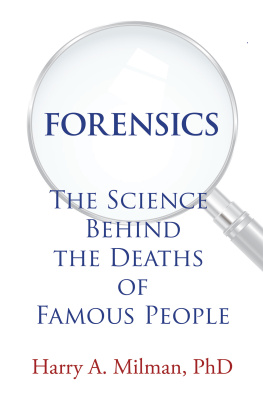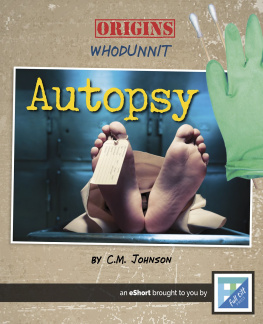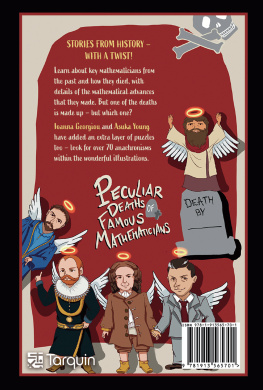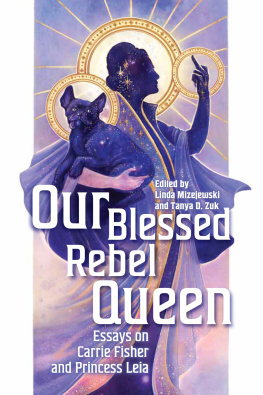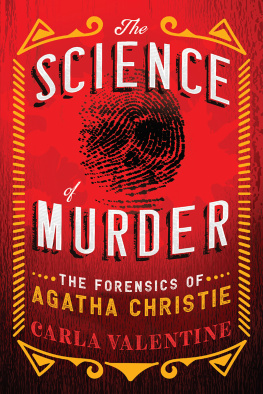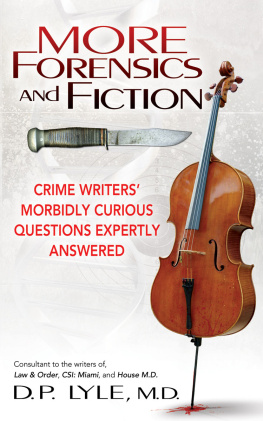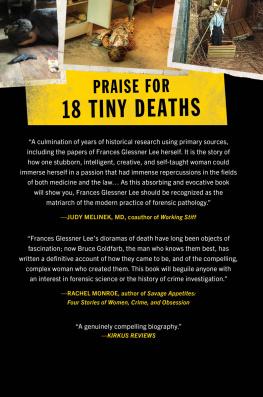FORENSICS
The Science Behind the
Deaths of Famous People
HARRY A. MILMAN, PHD
Copyright 2020 by Harry A. Milman, PhD.
Library of Congress Control Number: | 2020919977 |
ISBN: | Hardcover | 978-1-6641-3623-6 |
Softcover | 978-1-6641-3622-9 |
eBook | 978-1-6641-3621-2 |
All rights reserved. No part of this book may be reproduced or transmitted in any form or by any means, electronic or mechanical, including photocopying, recording, or by any information storage and retrieval system, without permission in writing from the copyright owner.
The views expressed in this work are solely those of the author and do not necessarily reflect the views of the publisher, and the publisher hereby disclaims any responsibility for them.
Any people depicted in stock imagery provided by Getty Images are models, and such images are being used for illustrative purposes only.
Certain stock imagery Getty Images.
Rev. date: 11/23/2020
Xlibris
844-714-8691
www.Xlibris.com
810738
CONTENTS
To indie authors everywhere
A SPECIAL THANK you to Caren Milman, whose careful editing and helpful suggestions made this book possible.
My sincere gratitude to Teri Hawn, Jeffrey Hyman, and Robert Emery, who provided critical and thoughtful insight and direction in the early phases of the manuscript.
Thank you to Jennifer McGinn of Jennifer McGinn Photography for her excellent photographic skills, especially during the COVID-19 pandemic. Youre the best!
Thank you to Elizabeth of the editorial staff of Xlibris for her excellent line editing and to Joe Scaggs for his commitment to excellence in the publication of all three of my books.
I am indebted to Barnes & Noble Booksellers and its nationwide staff who hosted me for more than 175 book-signing events since 2015.
And lastly, my heartfelt thanks to all my fans who supported me throughout the tortuous road to success.
IN 1888, PUBLIC fascination with criminal investigations was at an all-time high, mainly because of two highly publicized events. Jack the Ripper was murdering prostitutes and mutilating their bodies in areas in and around the Whitechapel district of London, and Sir Arthur Conan Doyle, the British author, published his Sherlock Holmes novels. Doyles books featured a private detective who used logic and forensic science, the application of scientific principles and methods to civil and criminal laws, to help solve crimes. Today, interest in forensics, especially among young people, continues to remain strong, mostly due to crime recreation television shows, as well as programs such as CSI: Crime Scene Investigation , Bones , and Cold Case . Equally important, there is a newly heightened public awareness in criminal investigations and the importance of securing a crime scene, how to avoid contaminating key evidence, and the power and limitations of laboratory tests.
Forensics in Crime Investigation
The use of forensics in a murder investigation can be traced back to 44 BC when the first officially recorded autopsy was conducted by Antistius, a Roman physician.
Xi Yuan Lu , translated as Washing Away of Wrongs, was the first treatise to describe the use of medicine and entomology, the scientific study of insects, to distinguish between suicide, murder, and an accidental death. Written by Song Ci during the Song dynasty, Xi Yuan Lu was published in China in the thirteenth century.
Henry Goddard of Londons Scotland Yard launched the field of forensic ballistics in 1835 when he connected a bullet to a murder weapon.
A classification system for analyzing fingerprints was created in 1896 by Sir Edward Richard Henry, Londons commissioner of the Metropolitan Police. Using the direction, flow, pattern, and other characteristics in fingerprints, suspects in crimes were now able to be more easily identified.
Modern-Day Forensics
Modern-day forensics is a scientific tool that helps identify and evaluate evidence in support of criminal and civil legal investigations. One of the most important scientific concepts that formed the basis of modern-day forensics was provided by Locard, the same French physician and criminologist who improved the science of fingerprint analysis.
Locard had a strong interest in forensic science and had worked as a medical examiner with the French Secret Service during World War I.
Forensic Toxicology
In the nineteenth century, arsenic, which has a sweet taste and could be mixed with food, was being used in poisonings because it left no visible signs of foul play and was untraceable in the body. Criminal investigations of arsenic poisonings were significantly improved when toxicology, the study of poisons, was introduced and quickly became recognized as an important forensic investigative tool.
Carl Wilhelm Scheele, a Swedish chemist and pharmacist who discovered oxygen and other elements, was studying methods for measuring arsenic in humans. He noticed that when arsenic oxide was chemically reacted with zinc and nitric acid, a gas with a distinctive garlic smell was formed.
The field of forensic toxicology was further enriched by the work of Karl Landsteiner on blood groups.
Since poisons must enter blood before they can exert their toxic effects, forensic toxicologists employ scientific principles dealing with absorption, distribution, metabolism, and elimination to determine the harmful effects caused by drugs and toxic chemicals.
Working in forensic laboratories, forensic toxicologists conduct physical and chemical tests on evidence obtained at crime scenes, acquired at autopsies, or obtained during drug monitoring. They utilize various analytical techniques, the most common of which are immunoassays using antibody reactions, to detect toxicants in bodily fluids.
Blood is the specimen of choice to establish whether human performance or behavior, as in driving, has been impaired by drugs or alcohol or whether a drug overdose has caused death. Unlike with blood, positive results in a urine test do not correlate with drug effects at the time of sampling. They merely identify drugs being eliminated from the body. Similarly, a positive finding of drugs in the liver, where metabolism occurs, or in the vitreous humor, the gel-like substance in the eye, indicates that the drugs had been consumed sometime prior to sampling. However, when a positive finding is obtained in a hair specimen, which is subject to contamination, or in fingernail or toenail clippings, it indicates that a drug had been consumed weeks or possibly even months before the sample was tested.
In postmortem forensic investigations, forensic pathologists and medical examiners perform autopsies and identify anatomical abnormalities that may be related to cause of death. Any blood, urine, or tissue specimens collected at the autopsy are then examined by forensic toxicologists who identify and quantify any toxicants present in the samples.
While forensics provides a scientific explanation for an injury or a disease that could then be used to determine cause of death, manner of death, for which there are five possible categoriesnatural, accident, suicide, homicide, and undeterminedis a medicolegal interpretation of the circumstances that led to a death. When manner of death is in dispute, it can lead to conspiracy theories.
In addition to their other activities, forensic toxicologists and other discipline-specific forensic experts often provide expert testimony at trials and depositions. Before they can testify, however, they must first pass the Daubert standard.
As a PhD pharmacologist and toxicologist with substantial experience reviewing medical and autopsy records, toxicology reports and the scientific literature, I have assisted in more than three hundred civil, criminal, and high-profile cases and have provided expert testimony at trials and depositions. In this book, I investigated the deaths of twenty-three famous people based on a review of publicly available autopsy and toxicology reports, as well as published scientific and lay articles. My aim was to demonstrate how forensics helps coroners determine that 51 percent or more of the evidence supports an opinion that death more likely than not was caused by drugs, chemical toxicants, or disease, the standard by which expert testimony is judged in court.
Next page
